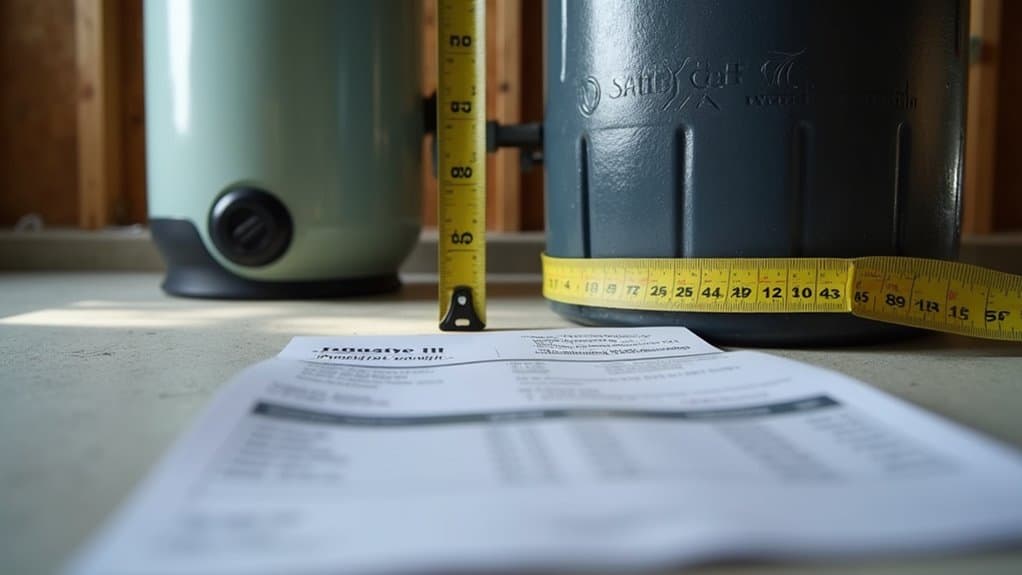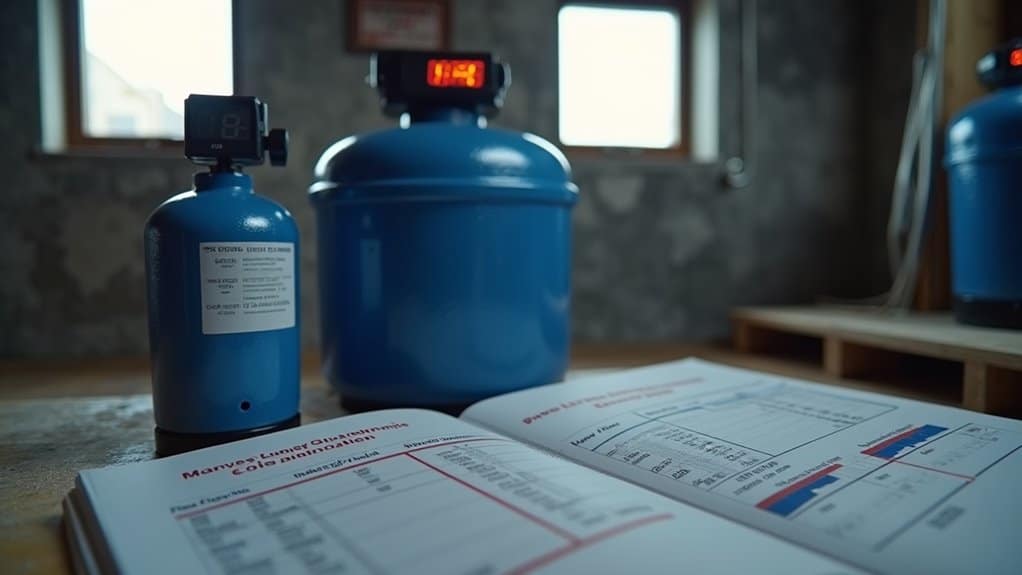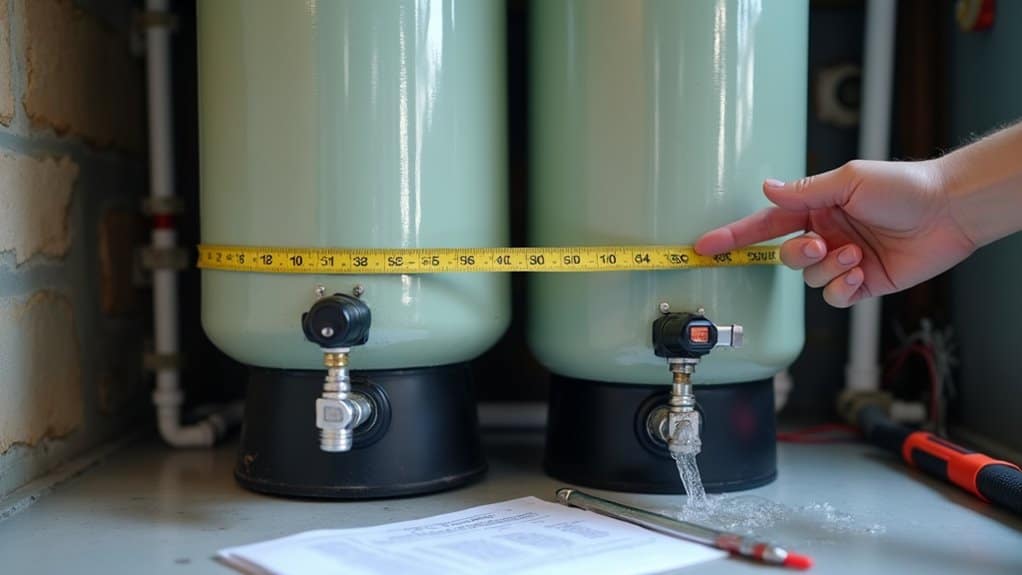Most water softener systems are deliberately oversized by plumbers, costing homeowners thousands in wasted equipment and salt. Instead of sizing based on your specific needs, professionals default to worst-case scenarios that boost their profits. To determine your actual requirement, multiply household size by daily water usage (75-100 gallons per person) and your water hardness level in grains per gallon. Our simple calculations below will save you significant money on equipment, salt, and wastewater.
Key Takeaways
- Most plumbers unnecessarily oversize water softeners, installing units with 2-3 times more capacity than households actually need.
- Oversized water softeners waste salt, using 15 pounds per regeneration cycle instead of the 6 pounds truly needed.
- Calculate your true needs by multiplying household size, daily water usage, and water hardness level in grains per gallon.
- Properly sized softeners should regenerate every 7-10 days for optimal efficiency, not based on standardized assumptions.
- Accurate peak flow rate measurements, not inflated Hunter’s Curve calculations, prevent paying for excessive system capacity.
Why Most Homes Have Oversized Water Softeners (And Pay Too Much)

When homeowners install water softeners, they routinely end up with systems far larger than necessary for their actual needs. This oversizing stems from inconsistent industry practices that ignore critical variables. Plumbers typically apply standardized assumptions rather than calculating specific household requirements based on actual water usage, hardness levels, and flow rates. They frequently overestimate reserve capacity and recommend excessive salt settings (15 lbs/cycle vs. efficient 6 lb alternatives).
The typical reliance on standardized sizing methods often leads to unnecessary costs and inefficiencies. Sizing decisions emphasize maximum capacity for rare peak-usage scenarios instead of average daily consumption. These oversized systems require less frequent regeneration cycles, but ultimately waste salt and water during each regeneration. The result? Homeowners pay more upfront and waste resources on systems designed for water demands they’ll rarely experience.
The Real Math Behind Water Softener Sizing Your Plumber Won’t Explain

Understanding the precise mathematics behind water softener sizing reveals why most plumbers’ recommendations lead to unnecessary expenses. The sizing formula is straightforward: multiply your total daily water consumption by your water’s hardness level measured in grains per gallon. For a family of four using 75-100 gallons per person daily, that’s 300-400 gallons total. With water testing at 10 gpg hardness, you’d need a system handling 3,000-4,000 grains daily.
Many professionals deliberately overestimate these calculations, suggesting units with double or triple the necessary capacity. This is often due to standard sizing charts that fail to account for unique household needs. Choosing an oversized softener can create issues like channeling problems that actually reduce effectiveness.
We’ve found that accurate measurements of your actual usage and hardness levels yield properly sized units that cost less initially and throughout their lifecycle.
Peak Flow Rates: The Critical Sizing Factor Everyone Ignores

While most sizing discussions focus on grain capacity, peak flow rates represent the most overlooked yet critical factor in proper water softener selection.
Hunter’s Curve calculations often overestimate requirements, but actual meter data provides superior accuracy. We recommend maintaining pressure loss below 15 PSI during peak flows, never exceeding 25 PSI. Additionally, optimal performance hinges on selecting the right size for your specific needs.
Remember, simultaneous fixture usage drives true demand – those moments when showers, dishwashers, and toilets operate concurrently. Similar to how Seasonic Prime PSUs are recommended for reliability during peak power demands, your water softener must handle maximum flow scenarios.
When sizing your system, account for valve diameter constraints and subtract manufacturer-specified pressure drops from line pressure. This ensures that the system can effectively manage the flow without sacrificing efficiency.
Without these calculations, even a high-grain capacity softener will underperform during peak demand, rendering its theoretical capacity meaningless.
DIY Sizing Guide: Calculate Your Exact Water Softener Needs in 5 Minutes

Sizing your water softener correctly requires just five key measurements and a simple calculation. We’ll guide you through determining your daily grain removal needs, the true foundation of proper sizing. Proper sizing ensures optimal performance and minimizes the risk of overworking the system.
First, multiply your household size by daily water usage (typically 80 gallons per person), then multiply by your water hardness level in GPG. Add iron compensation if applicable. Choosing incorrectly can result in wasted energy and frequent maintenance issues.
| Household Size | Daily Usage | Water Hardness | Daily Grains |
|---|---|---|---|
| 2 people | 160 gallons | 10 GPG | 1,600 |
| 4 people | 320 gallons | 10 GPG | 3,200 |
| 4 people | 320 gallons | 15 GPG | 4,800 |
Select a system with capacity that allows regeneration every 7-10 days for optimal efficiency.
Frequently Asked Questions
How Often Should Resin Be Replaced in Properly Sized Softeners?
We typically replace resins in properly sized water softeners every 10-15 years. However, we’ll need replacement sooner with high mineral content or contaminant exposure, even with optimal sizing.
Can I Downsize My Existing Softener Without Replacing the Entire System?
We don’t recommend downsizing existing softeners without replacement. Most systems aren’t modular. Consider partial resin replacement or installing bypass setups for non-essential fixtures to reduce load while maintaining your current unit.
How Do Water Softeners Affect Septic Systems?
We’ve found water softeners impact septic systems through system overloading from regeneration discharge, potential bacterial disruption from sodium, and possible tank corrosion. Redirecting discharge and using high-efficiency units minimizes these risks.
Are “Salt-Free” Water Conditioning Systems Effective Alternatives?
We find salt-free conditioners effective for scale prevention but not true softening. They don’t remove hardness minerals or address soap scum issues, though they’re environmentally friendly with minimal maintenance requirements.
Does Water Pressure Affect Softener Size Requirements?
Yes, water pressure directly affects softener sizing. We need minimum 20 PSI for proper operation, while excessive pressure above 80 PSI requires pressure regulators to prevent internal damage and inefficient regeneration cycles.
Conclusion
We’ve demonstrated how most water softeners are needlessly oversized by plumbers maximizing their profits. By understanding your actual grain capacity needs and accurate peak flow rates, you’ll save thousands over the system’s lifespan. Don’t trust arbitrary sizing formulas. Our calculation method ensures you’ll get precisely what your household requires—nothing more, nothing less. Measure twice, purchase once, and you’ll never overpay for water treatment again.

Craig “The Water Guy” Phillips is the founder of Quality Water Treatment (QWT) and creator of SoftPro Water Systems.
With over 30 years of experience, Craig has transformed the water treatment industry through his commitment to honest solutions, innovative technology, and customer education.
Known for rejecting high-pressure sales tactics in favor of a consultative approach, Craig leads a family-owned business that serves thousands of households nationwide.
Craig continues to drive innovation in water treatment while maintaining his mission of “transforming water for the betterment of humanity” through transparent pricing, comprehensive customer support, and genuine expertise.
When not developing new water treatment solutions, Craig creates educational content to help homeowners make informed decisions about their water quality.


